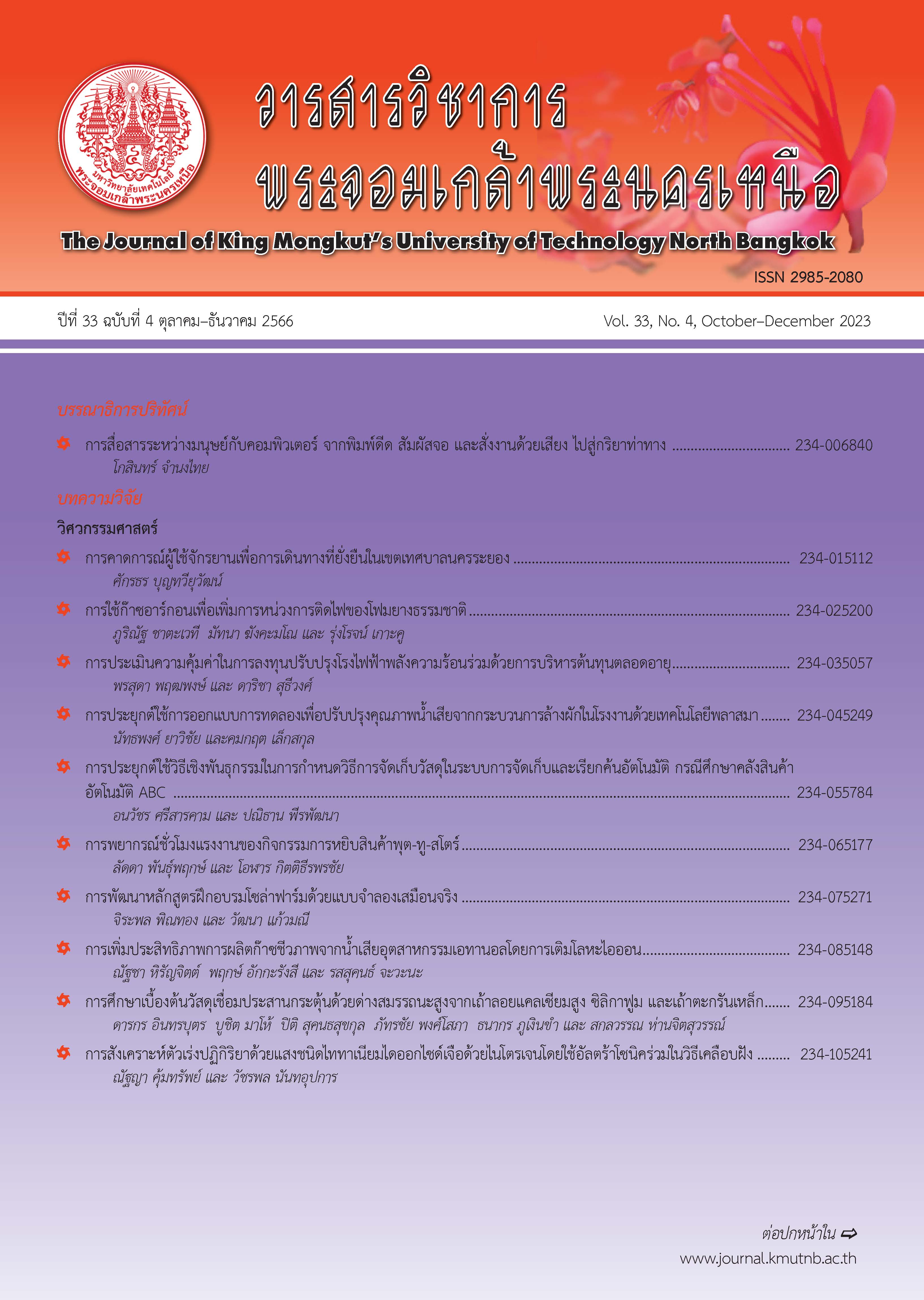ผลของการเย็นตัวต่ำกว่าจุดเยือกแข็งต่อความแข็งและออสเตไนต์เหลือค้างของเหล็กหล่อโครเมียมสูงที่มีปริมาณโครเมียม 16% และ 26%
Main Article Content
บทคัดย่อ
เหล็กหล่อโครเมียมสูงเป็นกลุ่มเหล็กหล่อทนการสึกหรอแบบขัดสีใช้ทำลูกรีดสำหรับรีดเหล็กในอุตสาหกรรมเหล็กกล้า และหม้อบดในอุตสาหกรรมปูนซีเมนต์ เนื่องจากมีความต้านทานการสึกหรอแบบขัดสีสูง ในทางปฏิบัติต้องการความแข็งสูงและมีออสเตไนต์เหลือค้างน้อยที่สุดเพื่อเพิ่มอายุการใช้งาน งานวิจัยนี้ได้ศึกษาผลของการเย็นตัวต่ำกว่าจุดเยือกแข็งร่วมกับการทำกรรมวิธีทางความร้อนทั่วไปต่อความแข็งและปริมาณออสเตไนต์เหลือค้างของเหล็กหล่อโครเมียมสูงที่มีส่วนผสม 16% และ 26% โครเมียม ซึ่งเป็นส่วนผสมพื้นฐานในการใช้งาน ชิ้นงานอบอ่อนถูกชุบแข็งด้วยอุณหภูมิ 1,050 องศาเซลเซียส และเย็นตัวโดยใช้ลมเป่าตามด้วยการเย็นตัวต่ำกว่าจุดเยือกแข็งในน้ำแข็งแห้งผสมอะซิโตน ทำการอบคืนไฟชิ้นงานชุบแข็งที่อุณหภูมิ 400–550 องศาเซลเซียส พบว่า ความแข็งในสภาพชุบแข็งของเหล็กหล่อทั้งสองส่วนผสม หลังจากผ่านการเย็นตัวต่ำกว่าจุดเยือกแข็งสูงกว่ากรณีเย็นตัวโดยใช้ลมเป่า สัดส่วนเชิงปริมาตรของออสเตไนต์เหลือค้าง ลดลงอย่างมากเมื่อผ่านการเย็นตัวต่ำกว่าจุดเยือกแข็ง ความแข็งในสภาพอบคืนไฟแสดงการแข็งขึ้นทุติยภูมิจากการตกตะกอนของคาร์ไบด์ทุติยภูมิและการแปลงเฟสจากออสเตไนต์เป็นมาร์เทนไซต์ ค่าสัดส่วนเชิงปริมาตรของออสเตไนต์เหลือค้างลดลงเมื่ออุณหภูมิอบคืนไฟสูงขึ้น ชิ้นงานที่ผ่านการเย็นตัวต่ำกว่าจุดเยือกแข็งมีระดับการแข็งขึ้นทุติยภูมิน้อยกว่าชิ้นงานที่เย็นตัวโดยใช้ลมเป่า ความแข็งสูงสุดหลังอบคืนไฟพบที่อุณหภูมิ 450–500 องศาเซลเซียส ชิ้นงานที่ผ่านการเย็นตัวต่ำกว่าจุดเยือกแข็งจะมีค่าความแข็งสูงสุดมากกว่าชิ้นงานที่เย็นตัวโดยใช้ลมเป่า ค่าความแข็งสูงสุดลดลงเมื่อปริมาณโครเมียมเพิ่มขึ้น 26% โดยค่าความแข็งสูงสุด คือ 810 HV30 ในชิ้นงาน 16% โครเมียม และ 781 HV30 ในชิ้นงาน 26% โครเมียม ที่ผ่านการเย็นตัวต่ำกว่าจุดเยือกแข็งซึ่งมีค่าสัดส่วนเชิงปริมาตรของออสเตไนต์เหลือค้างน้อยกว่า 4%
Article Details

อนุญาตภายใต้เงื่อนไข Creative Commons Attribution-NonCommercial-NoDerivatives 4.0 International License.
บทความที่ลงตีพิมพ์เป็นข้อคิดเห็นของผู้เขียนเท่านั้น
ผู้เขียนจะต้องเป็นผู้รับผิดชอบต่อผลทางกฎหมายใดๆ ที่อาจเกิดขึ้นจากบทความนั้น
เอกสารอ้างอิง
Abrasion resistant cast iron, 3rd ed. American foundry society, Des Plaines, 2000.
O. N. Dogan, J. A. Hawk, and G. Laird II, “Solidification structure and abrasive resistance of high chromium white irons,” Metallurgical and Materials Transactions A, vol. 28A, pp. 1315–1328, 1997.
G. Laird and G. L. F. Powell, “Solidification and solid-state transformation mechanisms in Si alloyed high-chromium white cast irons,” Metallurgical Transactions A, vol. 24, pp. 981–988, 1993.
R. B. Gundlach and J. L. Parks, “Influence of abrasive hardness on the wear resistance of high chromium irons,” Wear, vol. 46, pp. 97–108, 1978.
S. Inthidech, P. Sricharoenchai, and Y. Matsubara, “Effect of alloying elements on heatTreatment behavior of hypoeutectic high chromium cast iron,” Materials Transactions, vol. 47, no. 1, pp. 72–81, 2006.
G. II. Laird, “Microstructure of Ni-hard I, Ni- hard IV and high-Cr white cast irons,” American Foundry Society Transactions, vol. 95, pp. 339–357, 1991.
F. Maratray and A. Poulalion, “Austenite retention in High-Chromium white iron,” American Foundry Society Transactions, vol. 90, pp. 795–804, 1982.
Y. Matsubare, K. Ogi, and K. Matsuda. “Eutectic solidification of high chromium cast iron-eutectic structures and their quantitative analysis,” American Foundry Society Transactions, vol. 89, pp. 183–196, 1981.
M. Kuano, K. Ogi, and K. Matsuda, “Influence of destabilization heat treatment on martensitic transformation of high chromium cast iron,” The Journal of The Japan Found, vol. 54, pp. 586–592, 1982.
R. L. Pattyn, “Heat treatment of High-cr white irons,” American Foundry Society Transactions, vol. 97, pp. 161–167, 1993.
I. R. S Are and B. K. Arnold, “The effect of heat treatment on the gouging abrasion resistance of alloy white cast irons,” Metallurgical and Material Transaction A, vol. 26, pp. 357–370, 1995.
P. Kosasu, “Effect of silicon on abrasive wear behavior of Heat-treated 16% Cr - 2% Mo cast iron,” RMUTI Journal Science and Technology, vol. 12, no. 1, 2019 (in Thai).
P. Payson, “The Metallurgy of Tool Steels, Wiley, New York, 1962.
H. huaiLiu, J. Wang, B. luoShen, H. S. Yang, S. J. Gao, and S. J. Huang, “Effects of deep cryogenic treatment on property of 3Cr13Mo1V1.5 high chromium cast iron,” Materials and Design, vol. 28, no. 3, pp. 1059–1064, 2005.
H. Liu, J. Wang, H. Yang, and B. Shen, “Effects of cryogenic treatment on microstructure and abrasion resistance of CrMnB high-chromium cast iron subjected to sub-critical treatment,” Materials Science and Engineering A, vol. 478, no. 1–2, pp. 324–328, 2008.
H. S. Yang, J. Wang, B. L. Shen, H. H. Liu, S. J. Gao, S. Jiu, and Huang, “Effect of cryogenic treatment on the matrix structure and abrasion resistance of white cast iron subjected to destabilization treatment,” Wear, vol. 261, no. 10, pp. 1150– 1154, 2006.
Standard practice for X-Ray determination of retained austenite in steel with near random crystallographic orientation, ASTM E975-13, 2013.
C. Kim, “X-ray method of measuring retained austenite in heat treated white cast irons,” Journal of Heat Treating, vol. 1, pp. 43–51, 1979.

